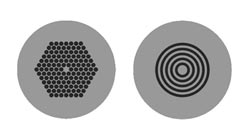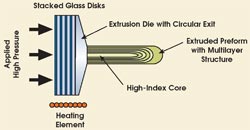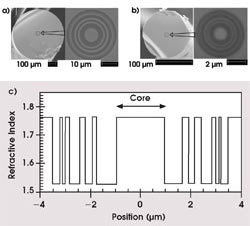Unique structure avoids deformations common with other holey fibers.
Breck Hitz, Senior Technical Editor
Typically, holey fibers are composed of glass, with a microstructure of tiny airholes surrounding the core. Several years ago, scientists at the University of Southampton in the UK demonstrated that holey fibers also can be constructed from two types of glass, with the lower-index glass substituting for the airholes in the microstructure. They called the fibers SOHO, short for solid holey. Now, they have shown that the SOHO technology enables creation of one-dimensional holey fibers, which may be more useful than two-dimensional fibers for generating nonlinear effects.

Figure 1. In a 2-D microstructured fiber, the high- and low-index materials form a familiar 2-D pattern (left). In a 1-D fiber, however, the pattern of high- and low-refractive materials varies in only a single, radial direction (right). Such a fiber would be mechanically impossible if the low-index material were air, but not when the low-index material is another glass.
Unlike the 2-D array in a regular holey fiber, the structure of a 1-D holey fiber is simply a series of concentric rings (Figure 1). The scientists fabricated the preform for this unusual structure by extruding a sandwich of high- and low-index glasses through a small aperture (Figure 2).

Figure 2. To fabricate the 1-D holey fiber, researchers made a sandwich of high- and low-index glasses and extruded it through a small aperture. The resulting preform had the desired cross section of multiple concentric rings. The scientists drew the preform down to a fiber in a conventional drawing tower.
As the viscous, softened glasses were forced through the extruder’s aperture, they turned into a preform with a multiple-concentric-ring cross section. The scientists drew the preform down to a 790-μm strand with an outer diameter of ~790 μm in a standard fiber-drawing tower. They took an 80-mm-long piece of the strand and inserted it into a jacket of the high-index glass with an inner diameter barely bigger than the strand (~800 μm) and an outer diameter of 18 mm. Finally, they returned to the drawing tower and drew the jacket-and-tube assembly into the final 1-D SOHO fiber.
The researchers created several fibers, with outer diameters ranging from 115 to 825 μm. Although the thicknesses of the glass disks in each original sandwich were uniform, the thicknesses of the concentric rings in the final fiber were definitely not. The investigators believe, however, that by understanding the relationship between the original sandwich and the structure of the final fiber, they could fabricate any desired structure.

Figure 3. The final stage of 2-D holey fiber formation is to draw the preform down to fibers with outer diameters of 825 μm (a), then 135 μm (b). The plot indicates the refractive index of a fiber with an outer diameter of 175 μm (c).
Unlike conventional air-glass holey fibers, the SOHO fibers show no evidence of deformation of the microstructure caused by the mechanical compressibility of air. The scientists believe that this is a major advantage because it enables the fabrication of fibers with a repeatable transverse structure — a trait required for creating fibers with predetermined optical characteristics.
They observed that their fibers were single mode at 1047 and 1560 nm but multimode at the wavelengths they tested under 1047 nm. They also measured an attenuation of ~3.6 dB/m at 1560 nm but estimate that the loss could be reduced to <0.5 dB/m by improving the fabrication process.
Significantly, they measured a nonlinearity of 260 ±30 W–1 km–1 in the fiber, a value 260 times greater than that of standard single-mode silica fiber, and concluded that the new fiber is a promising candidate for nonlinear fiber optic devices.
Applied Physics Letters, Vol. 87, 081110